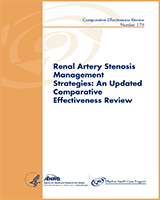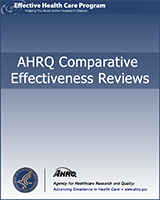NCBI Bookshelf. A service of the National Library of Medicine, National Institutes of Health.
This publication is provided for historical reference only and the information may be out of date.
Excerpt
This report summarizes the evidence evaluating the effect and safety of angioplasty with stent placements and medical therapies in the treatment of atherosclerotic renal artery stenosis (ARAS), particularly after long-term followup. The key questions and principal definition of terms were determined with the assistance of a technical expert panel.
Key questions addressed in this report are: 1. For patients with atherosclerotic renal artery stenosis in the modern management era (i.e., since JNC-5 in 1993a), what is the evidence on the effects of aggressive medical therapy (i.e., antihypertensive, antiplatelet, and antilipid treatment) compared to renal artery angioplasty with stent placement on long-term clinical outcomes (at least 6 months), including blood pressure control, preservation of kidney function, flash pulmonary edema, other cardiovascular events, and survival? 1a. What are the patient characteristics, including etiology, predominant clinical presentation, and severity of stenosis, in the studies? 1b. What adverse events and complications have been associated with aggressive medical therapy or renal artery angioplasty with stent placement? 2. What clinical, imaging, laboratory, and anatomic characteristics are associated with improved or worse outcomes when treating with either aggressive medical therapy alone or renal artery angioplasty with stent placement? 3. What treatment variables are associated with improved or worse outcomes of renal artery angioplasty with stent placement, including periprocedural medications, type of stent, use of distal protection devices, or other adjunct techniques?
Contents
- Preface
- Acknowledgments
- Executive Summary
- 1. Introduction
- 2. Methods
- 3. Results
- Direct Comparisons of Angioplasty (or Surgery) With Medical Treatment of Atherosclerotic Renal Artery Stenosis
- Medical Treatments for Blood Pressure or Lipid Control of Atherosclerotic Renal Artery Stenosis
- Natural History or Nonspecified Medical Treatments for Atherosclerotic Renal Artery Stenosis
- Angioplasty With Stent Placement of Atherosclerotic Renal Artery Stenosis
- Angioplasty of Atherosclerotic Renal Artery Stenosis
- Surgical Treatments of Atherosclerotic Renal Artery Stenosis
- Summary of Direct and Indirect Comparisons of Angioplasty to Medical Therapy for Treatment of Atherosclerotic Renal Artery Stenosis
- 4. Summary and Discussion
- 5. Future Research
- References
- List of Abbreviations/Acronyms
- Appendixes
Prepared for: Agency for Healthcare Research and Quality, U.S. Department of Health and Human Services.1 Contract No. 290-02-0022. Prepared by: Tufts-New England Medical Center EPC, Boston, Massachusetts.
Suggested citation:
Balk E, Raman G, Chung M, Ip S, Tatsioni A, Alonso A, Kupelnick B, Chew P, DeVine D, Gilbert S, Lau J. Comparative Effectiveness of Management Strategies for Renal Artery Stenosis. Comparative Effectiveness Review No. 5. (Prepared by Tufts-New England Medical Center Evidence-based Practice Center under Contract No. 290-02-0022). Rockville, MD: Agency for Healthcare Research and Quality. Available at www.effectivehealthcare.ahrq.gov/reports/final.cfm.
None of the investigators has any affiliations or financial involvement that conflicts with the material presented in this report.
This report is based on research conducted by the Tufts-New England Medical Center Evidence-based Practice Center (EPC) under contract to the Agency for Healthcare Research and Quality (AHRQ), Rockville, MD (Contract No. 290-02-0022). The findings and conclusions in this document are those of the authors, who are responsible for its contents; the findings and conclusions do not necessarily represent the views of AHRQ. Therefore, no statement in this article should be construed as an official position of the Agency for Healthcare Research and Quality or of the U.S. Department of Health and Human Services.
This report is intended as a reference and not as a substitute for clinical judgment. Anyone who makes decisions concerning the provision of clinical care should consider this report in the same way as any medical reference and in conjunction with all other pertinent information.
This report may be used, in whole or in part, as the basis for development of clinical practice guidelines and other quality enhancement tools, or as a basis for reimbursement and coverage policies. AHRQ or U.S. Department of Health and Human Services endorsement of such derivative products may not be stated or implied.
- 1
540 Gaither Road, Rockville, MD 20850. www
.ahrq.gov
- Review Renal Artery Stenosis Management Strategies: An Updated Comparative Effectiveness Review[ 2016]Review Renal Artery Stenosis Management Strategies: An Updated Comparative Effectiveness ReviewBalk EM, Raman G, Adam GP, Halladay CW, Langberg VN, Azodo IA, Trikalinos TA. 2016 Aug
- Review Primary stenting for atherosclerotic renal artery stenosis.[J Vasc Surg. 2010]Review Primary stenting for atherosclerotic renal artery stenosis.Steichen O, Amar L, Plouin PF. J Vasc Surg. 2010 Jun; 51(6):1574-1580.e1.
- Review From the 1990s to CORAL (Cardiovascular Outcomes in Renal Atherosclerotic Lesions) trial results and beyond: does stenting have a role in ischemic nephropathy?[Am J Kidney Dis. 2015]Review From the 1990s to CORAL (Cardiovascular Outcomes in Renal Atherosclerotic Lesions) trial results and beyond: does stenting have a role in ischemic nephropathy?Böhlke M, Barcellos FC. Am J Kidney Dis. 2015 Apr; 65(4):611-22. Epub 2015 Jan 31.
- The benefit of STent placement and blood pressure and lipid-lowering for the prevention of progression of renal dysfunction caused by Atherosclerotic ostial stenosis of the Renal artery. The STAR-study: rationale and study design.[J Nephrol. 2003]The benefit of STent placement and blood pressure and lipid-lowering for the prevention of progression of renal dysfunction caused by Atherosclerotic ostial stenosis of the Renal artery. The STAR-study: rationale and study design.Bax L, Mali WP, Buskens E, Koomans HA, Beutler JJ, Braam B, Beek FJ, Rabelink TJ, Postma CT, Huysmans FT, et al. J Nephrol. 2003 Nov-Dec; 16(6):807-12.
- Intracranial angioplasty and stent placement after stenting and aggressive medical management for preventing recurrent stroke in intracranial stenosis (SAMMPRIS) trial: present state and future considerations.[J Neuroimaging. 2012]Intracranial angioplasty and stent placement after stenting and aggressive medical management for preventing recurrent stroke in intracranial stenosis (SAMMPRIS) trial: present state and future considerations.Qureshi AI, Al-Senani FM, Husain S, Janjua NA, Lanzino G, Lavados PM, Nguyen T, Raymond J, Shah QA, Suarez JI, et al. J Neuroimaging. 2012 Jan; 22(1):1-13.
- Comparative Effectiveness of Management Strategies for Renal Artery StenosisComparative Effectiveness of Management Strategies for Renal Artery Stenosis
- LOC131374348 [Mus musculus]LOC131374348 [Mus musculus]Gene ID:131374348Gene
- 32-37FUv-mDC-SM_S12432-37FUv-mDC-SM_S124GEO DataSets
Your browsing activity is empty.
Activity recording is turned off.
See more...

